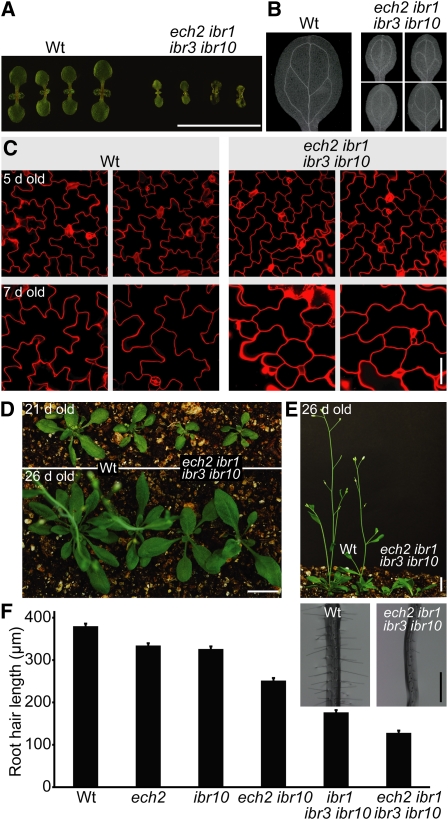Figure 4.
ech2 Enhances ibr1 ibr3 ibr10 Cell Expansion Defects.
(A) Seven-day-old light-grown ech2-1 ibr1-2 ibr3-1 ibr10-1 seedlings display decreased cotyledon size compared with wild-type (Wt) seedlings. Bar = 1 cm.
(B) Eight-day-old light-grown ech2-1 ibr1-2 ibr3-1 ibr10-1 seedlings display aberrant vascular patterning. Bar = 1 mm.
(C) Five-day-old (top panels) and 7-d-old (bottom panels) ech2-1 ibr1-2 ibr3-1 ibr10-1 seedlings display small cotyledon epidermal cells. Confocal images of propidium iodide–stained cells are shown. Bar = 50 μm.
(D) Soil-grown ech2-1 ibr1-2 ibr3-1 ibr10-1 plants are smaller than the wild type at 21 d (top panel) but begin to recover by 26 d (bottom panel). Two wild-type (left) and quadruple mutant (right) plants are shown. Bar = 1 cm.
(E) Soil-grown ech2-1 ibr1-2 ibr3-1 ibr10-1 plants flower later than the wild type. Profile of plants shown in (D). Bar = 1 cm.
(F) ech2 mutants display short root hairs. Mean root hair lengths (+se; n = 500) of 5-d-old wild-type, ech2-1, ibr10-1, ech2-1 ibr10-1, ibr1-2 ibr3-1 ibr10-1, and ech2-1 ibr1-2 ibr3-1 ibr10-1 light-grown seedlings. Inset: Root hairs from 5-d-old wild-type and ech2-1 ibr1-2 ibr3-1 ibr10-1 light-grown seedlings. Bar = 500 μm.

